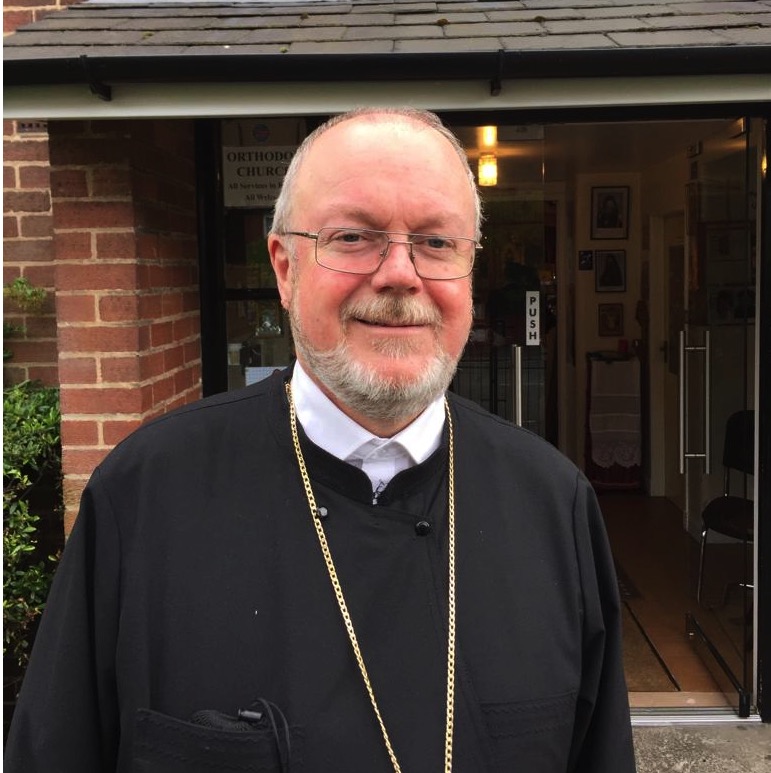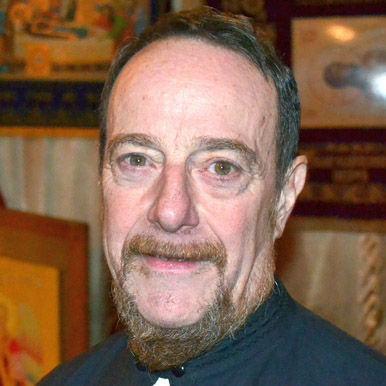Tonight, the theme of “Living the Liturgy” will be linked with a reflection on what the Nicene Creed means in each of our lives. As Father Michael Pomazansky has written in Orthodox Dogmatic Theology, “In the Christian understanding, to believe in God signifies not only to acknowledge God with the mind, but also to strive towards Him with the heart” (p. 53). What we are seeking tonight and in the days and months and years to come is what the English poet William Cowper called—“a closer walk with God,” a better understanding of the presence of God—Father, Son and Holy Spirit—within the Church and within our own lives. In 1767 William Cowper wrote: “O for a closer walk with God,/ A calm and heavenly frame,/ A light to shine upon the road/ that leads me to the Lamb!”
The Lamb, of course, is Christ, whose presence we seek as we walk along the road of life. So what precisely, in Cowper’s beautiful phrase, is that “light to shine upon the road that leads me to the Lamb”? Who is Christ? That was the question that the First Ecumenical Council tackled at Nicea—modern Iznik in Turkey today. Let’s look more closely at that creed whose theology was agreed at the Council of Nicea in 325 and whose wording was proclaimed at the Council of Constantinople in 381.
The fourth century Orthodox theologian, St Gregory of Nazianzus, known as St Gregory the Theologian, has helpfully explained to us in Oration 31 about, to use his words, “the order in which God is revealed,” that is, how our understanding of The Holy Trinity grew. St Gregory wrote: “The Old Testament clearly showed the Father, but only dimly showed the Son. The New Testament revealed the Son and hinted at the divinity of the [Holy] Spirit. Today the [Holy] Spirit lives among us and is making himself more clearly known.” That was true in the fourth century and remains true today! St Gregory continues: “As long as the divinity of the Father had not been recognized, it was dangerous to preach openly the Son; in the same way, as long as the divinity of the Son was not admitted, it was dangerous to impose, if we dare to use such words, the belief in the divinity of the [Holy] Spirit as an added burden. You see the order in which God is revealed [is] an order that we must respect in our own turn: not revealing everything in a rush and without discernment but also not keeping anything hidden until the end of time…” [end of quote]. So tonight let’s adopt that approach from St Gregory and seek to understand the Holy Trinity slowly, not “in a rush,” but with discernment. Let us seek to understand first the Father, then the Son, then the Holy Spirit, and then how the Holy Spirit guides the Church which proclaims the Holy Trinity in the Nicene Creed.
During every Divine Liturgy we say the words of the Nicene Creed beginning: “I believe in one God, the Father almighty, maker of heaven and earth, and of all things visible and invisible.” As Father Vassilios Papavasssiliou reminds us in his little book, Journey to the Kingdom: An Insider’s Look at the Liturgy and Beliefs of the Eastern Orthodox Church, “It is worth noting that we say, ‘I believe,’ not ‘we believe” [because] the Creed was originally and still is a baptismal creed.” These are the words every new Christian or their sponsors say before being baptised.
In expressing our belief in God the Father, we are affirming the call in the Old Testament book of Deuteronomy, chapter 6, verses 4 to 7: “Hear, O Israel: The Lord our God is one Lord; and you shall love the Lord your God with all your heart, and with all your soul, and with all your might. And these words which I command you this day shall be upon your heart; and you shall teach them diligently to your children, and shall talk of them when you sit in your house, and when you walk by the way, and when you lie down, and when you rise…” This is the same God the Father proclaimed in the New Testament in Ephesians, chapter 4, verses 5 and 6, who is, and I quote, “the one God and Father of us all, who is above all and through all and in all” [end of quote]. This is God who according to the opening verse of the book of Genesis, “created the heavens and the earth.”
The next six parts of the Creed concern the Son of God—His beginning, His Incarnation, His suffering and death, His glorious Resurrection, His Ascension and His Second Coming. In the Gospel of St Matthew, chapter 14, verse 33, the apostles see Jesus Christ walk on the water in the midst of a storm and then reach out to save Peter. Then, as St Matthew writes, “Those in the boat worshipped Him, saying, ‘Truly, you are the Son of God.” St John Chrysostom, in preaching of this passage, explains how Christ leads the apostles to recognise His divinity. I quote: “Do you see how by degrees Jesus was leading them all higher and higher? For by His walking on the sea, and by His commanding another to do so and by preserving Peter in jeopardy, their faith was henceforth great” [end of quote]. As we attend the Divine Liturgy again and again, as we pray day after day, we too are led slowly “by degrees” with increasing discernment to see Jesus Christ, as truly the Son of God.
The Nicene Creed continues: “And I believe in the Holy Spirit, the Lord and giver of life, who proceeds from the Father, who with the Father and the Son together is worshipped and glorified. . . .” In the original formulation in 325, the Creed ended with the words, “And in the Holy Spirit,” but four anathemas against Arianism were also included—four rejections of the doctrine that Christ is not divine. In the Gospel of St John, chapter 14, verse 26, the Evangelist tells us in the words of Jesus Christ: “The Counsellor, the Holy Spirit, whom the Father will send in My name, He will teach you all things, and bring to your remembrance all that I have said to you.”
The Nicene Creed helps us to understand and to remember the role of the Holy Spirit in the Church and in our lives. In the opening chapter of the Acts of the Apostles, verse 4, the apostles are told “not to depart from Jerusalem, but to wait for the promise of the Father,” that is, the presence of the Holy Spirit in their lives. That advice applies to each of us as well. We too need to wait for the presence of the Holy Spirit as we walk along the road of life. Sometimes, we will have difficult problems that we do not know how to solve. St Luke tells us in chapter 12, verses 11 and 12, that in a difficult situation where accusations are being made against the apostles (or us), “do not be anxious how or what you are to answer or what you are to say; for the Holy Spirit will teach you in that very hour what you ought to say.”
At other times, the Holy Spirit can guide us to bring others to Christ, just as the Holy Spirit guided the apostles in Acts, chapter 2 on the day of Pentecost. The Nicene Creed affirms that “I believe in one, holy, catholic and apostolic church” and that “I acknowledge one baptism for the remission of sins.” Those same apostles who were told to wait in Jerusalem for the Holy Spirit to come to them, were later told, as set out in the Gospel of St Mark, chapter16, verse 15, to “Go into all the world and preach the Gospel to the whole creation.”
That can happen to us, too, if we wait until we are called to act in the name of Christ in a specific situation where we are needed. We too are disciples of Christ. We too can learn to wait for the Holy Spirit to guide us. Before I or you can know the Nicene Creed, we each need to mould the knowledge of “my self” into an understanding of “my Christ.” I conclude with the words of another English poet, Francis Quarles, writing early in the 17th century. His poem is called “Christ and Our Selves.” He writes: “I wish a greater knowledge, then [to] attaine/ The knowledge of my selfe: A greater Gaine/Then to augment my selfe; A greater Treasure/ Then to enjoy my selfe: A greater Pleasure/ Then to content my selfe; How slight, and vaine/ Is all selfe-Knowledge, Pleasure, Treasure, Gaine;/ Unlesse my better knowledge could retrieve/ My Christ; unles my better Gaine could thrive/ In Christ; unless my better Wealth grow rich/ In Christ; unles my better Pleasure pitch/ On Christ.” Quarles concludes: “Lord, keepe me from my Selfe; ‘Tis best for me,/ Never to owne my Selfe, if not in Thee.”
So may it be for each of us: May we slowly learn “by degrees” how to live the Nicene Creed, how to bring ourselves into unity with Christ.

 Archpriest Gregory Hallam
Archpriest Gregory Hallam
 Fr. Emmanuel Kahn
Fr. Emmanuel Kahn